Sense of history gives Xitang modern appeal
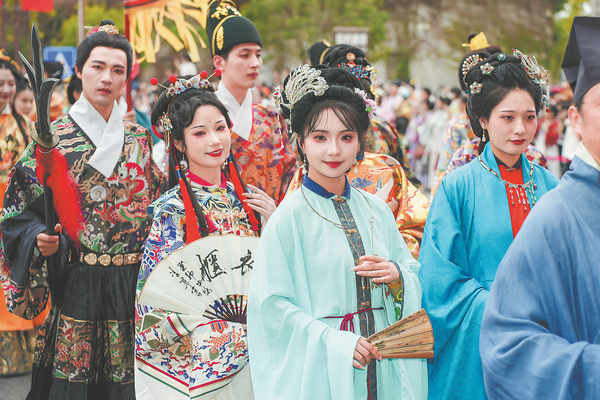
The hanfu cultural week in Xitang sees many visitors don the traditional dress last year. CHINA DAILY
Water town attracts droves of tourists with its historical, relaxing ambience, Wang Ru reports in Jiaxing, Zhejiang province.
A scene in Mission Impossible III involving Tom Cruise running through the small alleys of a picturesque town in China left a deep impression on some of those who watched and propelled Xitang, an ancient town in Jiashan county, Jiaxing, Zhejiang province, where the scene was filmed in 2005, to a leading role in tourism.
Walking along Xitang's canals, visitors may feel like they are in a Chinese ink painting with blue-stone roads, quaint alleys and houses built in the distinctive style of Huizhou, a historical prefecture that straddled the border between southern Anhui province and the north of Jiangxi province, where homes have white walls, dark tiles and layered horse-head gables.
Even after nearly two decades, the water town is still packed with visitors who come to appreciate its scenery and culture.
Over the ages, Xitang's development has been closely related to culture, which has endowed the ancient town with new grandeur, says Han Jinmei, a cultural scholar from Jiashan county, who is also former deputy director of Jiashan's cultural bureau.
He says that three types of culture are interwoven in the town — farming, commerce and the common culture — and adds that Xitang also has a distinctive farming culture that can trace its roots back to the Tang Dynasty (618-907).
Farmers bartered and traded for daily necessities in the town, gradually turning it into a thriving market during the Song Dynasty (960-1279). Then in the Qing Dynasty (1644-1911), as merchants from Huizhou migrated eastward to Xitang, more and more people came to settle in the town to provide services to the farmers, gradually turning it into a commercial center.
"Many of the merchants' ancestors were farmers. The formation, development in scale and improvements to the living facilities of the town are all related to farming. That's why we say it has a deep farming culture," Han explains.
This culture can still vividly be seen in the Jiashan tiange (literally "field songs") that farmers sang as they labored in the fields. It has been recognized as a national-level intangible cultural heritage, and is characterized by its clear and melodious style and storytelling.
"Every tour guide in Xitang can sing tiange. They often demonstrate the traditional art to tourists so that they can enjoy it," Han says.
In the middle of the Qing Dynasty, some Huizhou merchants brought their aesthetic values and business styles with them, giving rise to a genteel culture in Xitang, Han says.
"Huizhou merchants brought Huizhou-style buildings, with their layered horse-head gables, which Xitang hadn't had previously. Moreover, they were famous for their credibility and benevolence, and brought this spirit of doing business to Xitang, as well."
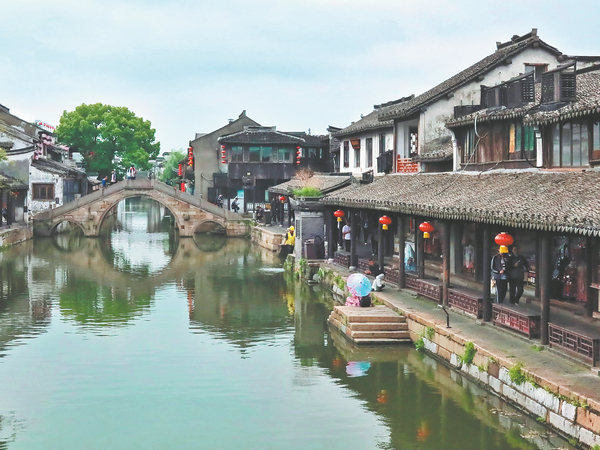
The picturesque view of the ancient town of Xitang in Jiaxing, Zhejiang province, has the typical elements of a traditional landscape painting. JIANG DONG/CHINA DAILY
Han underscores the town's corridor sheds, some of which extend for nearly 1,000 meters. They were the invention of Huizhou merchants, who built the sheds in front of their shops to give customers shelter in bad weather like heavy wind, rain or snow.
"This shows their consideration for customers, and the Xitang corridor shed is viewed as a reflection of its genteel merchant culture," he says.
As few illustrious families lived in Xitang, there are only few high-level architectural complexes left. This is markedly different from other famous ancient towns in Zhejiang, such as Nanxun ancient town in Huzhou. Consequently, Xitang's inhabitants developed their own attitudes and cultural personalities.
"Xitang people prefer to keep a low-key profile. They don't have much demand for luxuries. They are more relaxed about life. They don't care too much about income or social status. They just enjoy living a simple life," Han says, adding that they are also tolerant and open-minded. This can be seen in their acceptance of tourists leaving messages on one of the town's bridges, the Songzi Laifeng Bridge (Bridge of Bringing Sons and Daughters), which is covered in graffiti.
"Residents don't mind the walls of the bridge being covered with graffiti, so tourists can feel free to draw whatever they wish. When they become too heavily covered, we just whitewash them so that people can continue," Han says.
Local authorities started to develop tourism in 1996. They have tried to protect original features and have developed the area on the basis of protecting old buildings, waterways, bridges and alleys and retaining the original residents.
One side of the town is the prosperous business district, with rows of shops along the water. This scene hasn't changed since the Qing Dynasty. Often located just behind the shops are people's homes.
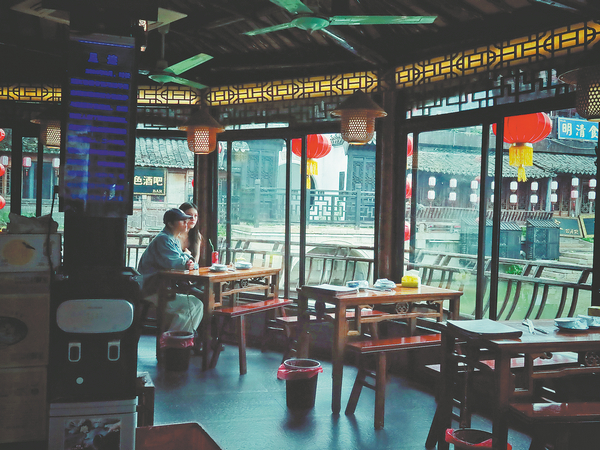
A restaurant in the town provides a perfect setting to appreciate the scenery. JIANG DONG/CHINA DAILY
"Their homes have been upgraded to make their lives easier, but the appearance of their houses has largely retained the original features. We want to preserve the traditional landscape, but we also must ensure that people live a convenient life," Han adds.
There are still 2,600 households in the town. "With residents, the town is not just a scenic spot for tourists, but a community for people," says Sun Yuqing, a tour guide in Xitang.
The ancient town is also famous for pankou (literally "coiled buttons"), Chinese knot buttons made from cloth or other fine materials. They are used as fasteners or decorative elements on traditional clothing.
Peng Lihua, an inheritor of button-making, who has been involved in the craft for more than two decades, says that pankou dates back more than a millennium. The knot buttons are entirely made by hand and come in various styles.
In recent years, pankou has enjoyed boom, and has been turned into new items, such as small pieces of jewelry, with earrings, necklaces and brooches made using elements of it. Residents also make paintings with pankou elements, creating a new derivative of the ancient product that can be used as a home furnishing, Peng says.
She says that Dashun village in Xitang is regarded as "the hometown of buttons" since about 40 percent of modern buttons in China are produced there.
The increasing popularity of traditional pankou in recent years is inseparable from the rise in wearing hanfu, or traditional Chinese clothing.
According to Hang Bin, a town official, since 2013 when Taiwan lyricist Vincent Fang started the first hanfu cultural week in Xitang, the annual event, which takes place every October, has attracted more than 1 million visitors.
During the festival, people wearing traditional Chinese clothes get free admission to the town and can take part in activities like re-creations of traditional ceremonies, flower-decorated boat parades and script-based role-playing games.
The cultural week attracts overseas fans as well. Enthusiasts from more than 20 countries and regions, including the Republic of Korea, Malaysia and South Africa, have joined in cultural activities pertaining to hanfu.
"Hanfu is a reflection of traditional Chinese culture. We believe organizing this event is beneficial both for cultural protection and tourist development. As a result, we continue to develop hanfu-making and associated businesses, and the trade has now become prosperous," Hang says.
There are now more than 100 shops offering hanfu and customized makeup styling services to tourists at Xitang as a result, Sun says.
One such boutique was opened by Nabil al-Aghbari, a 58-year-old businessman from Yemen and his wife, Yin Hongxia.
"Eight years ago, I fell in love with Xitang during a visit. It was so beautiful and tranquil, far from the hustle and bustle of cities, and I wanted to be here," says the Yemeni businessman, who was involved in foreign trade in Yiwu, Zhejiang, before settling in Xitang.
As he walked around the town during hanfu cultural week in 2016, he was amazed. "Hanfu dresses are exquisite and match the atmosphere of this old town. As a result, I decided to open a hanfu shop here," he says.
He often shows the clothes to international visitors and helps them try them on. "I hope hanfu culture spreads so that more people will try the clothes. I believe the more traditional it is, the more global appeal it has," he says.




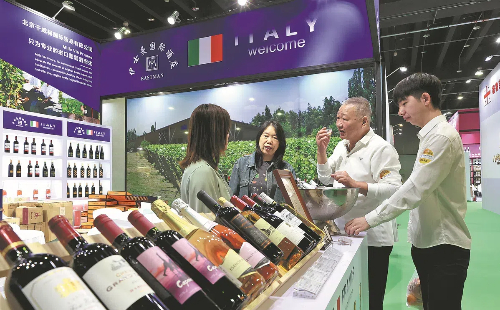
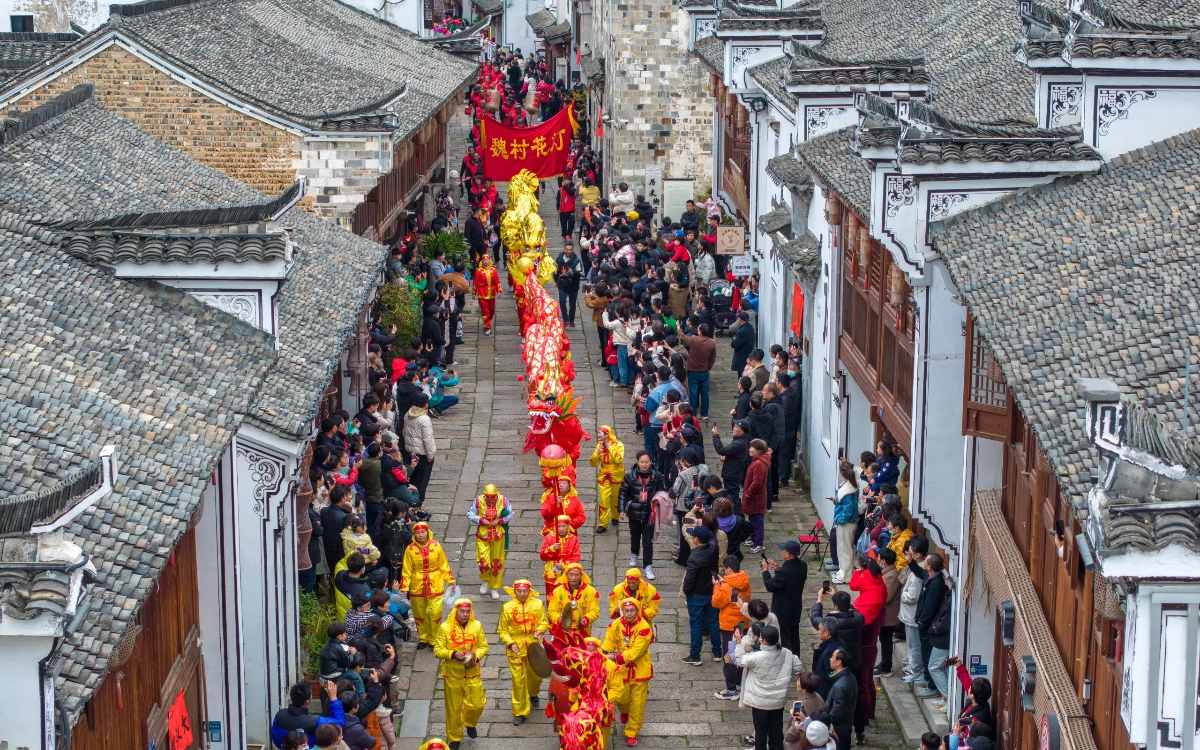 play
play